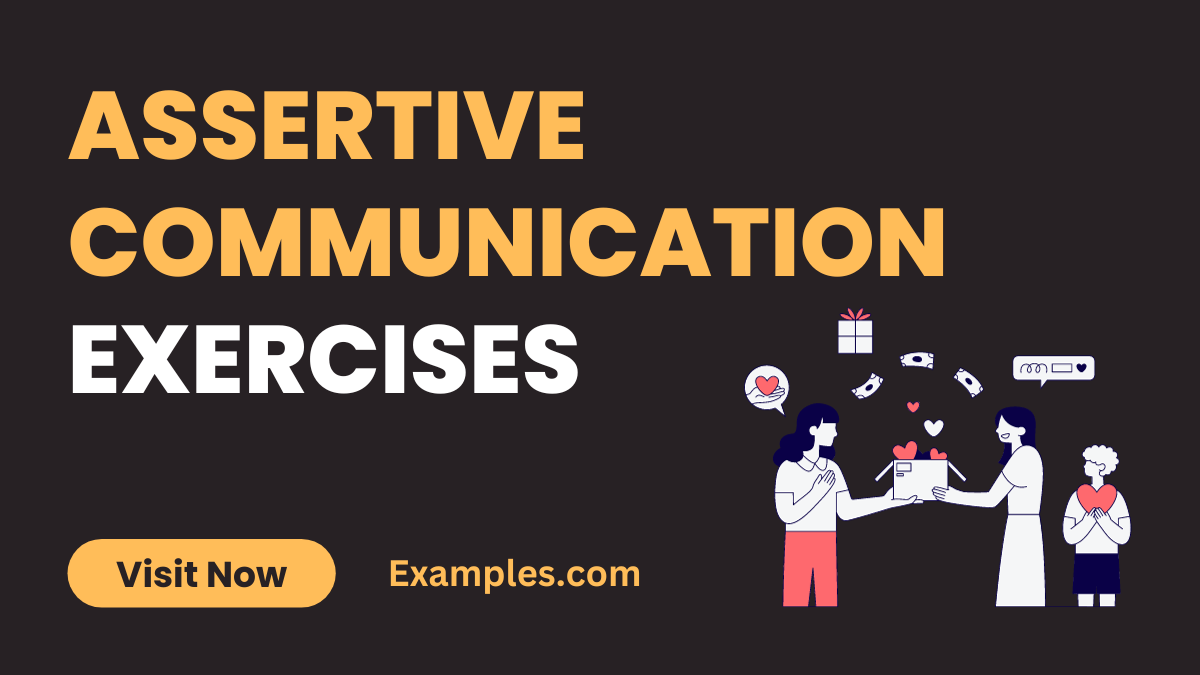19+ Assertive Communication Exercises Examples
Embark on a journey to master the art of assertive communication with our Complete Guide to Assertive Communication Exercises. This guide, enriched with practical communication examples, is designed to empower you with the skills needed for confident and respectful interactions. Whether you’re in a professional setting or managing personal relationships, these exercises will enhance your ability to communicate your needs and opinions clearly. Dive into this guide to transform your communication style, ensuring every conversation is impactful and respectful.
20 Examples of Assertive Communication Exercises
Dive into the world of assertive communication with our curated selection of 20 Assertive Communication Exercises. These exercises are designed to strengthen your ability to express yourself confidently and respectfully in various scenarios. From the workplace to personal relationships, mastering these techniques will significantly improve your communication style. Each example is a step towards a more assertive you, helping you navigate conversations with clarity, empathy, and confidence. Let’s explore these exercises and transform the way you communicate.

- Role-Playing Challenging Conversations: Practice difficult conversations with a friend or colleague, focusing on maintaining a calm tone and clear message.
- Active Listening Role Reversal: Pair up and alternate sharing thoughts, ensuring the listener paraphrases the speaker’s message for accurate understanding.
- ‘I Statement’ Practice: Create scenarios where you express your feelings using ‘I statements’ to avoid blaming and foster constructive dialogue.
- Feedback Exchange Sessions: Regularly exchange feedback with peers, focusing on delivering it constructively and receiving it open-mindedly.
- Boundary Setting Role-Play: Practice setting personal boundaries in different scenarios, emphasizing the importance of clear, direct communication.
- Assertive Email Writing: Draft emails that are assertive yet polite, focusing on being concise and clear with your requests or responses.
- Non-Verbal Communication Awareness: Engage in activities that focus on non-verbal assertiveness, like maintaining eye contact and confident body language.
- Empathy Building Exercises: Participate in exercises that enhance empathy, essential for understanding others’ perspectives in assertive communication.
- Conflict Resolution Practice: Role-play conflict scenarios to develop skills in navigating disagreements assertively and respectfully.
- Assertive Public Speaking: Practice speaking on various topics in front of a group, focusing on clear, confident delivery.
- Positive Affirmation Recitation: Regularly recite positive affirmations to boost self-confidence in your communication abilities.
- Constructive Criticism Role-Playing: Practice giving and receiving constructive criticism, focusing on growth and improvement.
- Self-Advocacy Scenarios: Engage in scenarios where you have to advocate for yourself, practicing clarity and firmness in your communication.
- Asking for Help Assertively: Role-play scenarios where you assertively ask for help, balancing politeness with directness.
- Handling Criticism Exercises: Learn to handle criticism assertively, responding with acknowledgment and openness to improvement.
- Direct Communication Practice: Develop scenarios where you practice being direct yet respectful in your communication.
- Solution-Oriented Discussion Drills: Focus discussions on finding solutions, encouraging a positive and assertive communication approach.
- Respectful Disagreement Exercises: Engage in debates where you practice disagreeing respectfully and assertively.
- Clarifying Misunderstandings: Practice assertive communication in scenarios where misunderstandings need to be clarified.
- Expressing Needs and Desires: Role-play situations where you assertively express your needs and desires, ensuring your message is clear and respectful.
List of Training Exercises for Assertive Communication
Discover a comprehensive list of training exercises specifically designed for enhancing assertive communication. These exercises are tailored to develop the skills necessary for expressing yourself effectively and respectfully in various situations. Whether you’re looking to improve workplace interactions or seeking personal development, these training exercises provide practical approaches to cultivate assertiveness. From improving verbal communication to enhancing non-verbal cues, this guide offers a wide range of activities to help you communicate with confidence and clarity.
- Mirror Practice for Body Language: Stand in front of a mirror and practice your body language, making sure it conveys confidence and openness.
- ‘No’ Saying Exercise: Practice saying ‘no’ in different ways to become comfortable with declining requests without feeling guilty or aggressive.
- Persuasive Speaking Drill: Work on delivering persuasive speeches on various topics, focusing on assertiveness and clarity in your arguments.
- Assertive Communication in Group Discussions: Participate in group discussions, practicing to voice your opinion assertively while respecting others’ views.
- Scenario-Based Assertive Response Writing: Write responses to different scenarios, focusing on assertive yet respectful language.
- Empathetic Listening and Response Activity: Engage in listening exercises where you respond empathetically and assertively, balancing understanding with expressing your own viewpoint.
- Positive Self-Affirmation Routine: Develop and practice a routine of positive self-affirmations that reinforce your self-confidence and ability to communicate assertively.
- Practicing Assertive Requests: Role-play situations where you need to make requests assertively, ensuring you’re clear and direct.
- Constructive Disagreement Practice: Practice articulating disagreements constructively, focusing on maintaining a respectful tone and finding common ground.
- Reflection and Journaling on Communication: Keep a journal to reflect on your daily communications, identifying areas where you were assertive and areas for improvement.
Assertive Communication Exercises for Students
Assertive Communication Exercises for Students are tailored to enhance communication skills in an academic context. These exercises focus on developing assertiveness in interactions with peers, faculty, and in classroom discussions. Ideal for students at various educational levels, these exercises aim to foster a communication style that is confident, respectful, and effective. By engaging in these exercises, students can significantly improve their academic performance, social interactions, and prepare for future professional environments.

- Assertive Group Discussion Involvement: Practice participating in group discussions, ensuring your points are made confidently and considerately.
- Feedback Seeking in Academic Work: Learn how to assertively seek feedback on your academic work, showing a proactive approach to learning.
- Assertive Communication in Peer Tutoring: Engage in peer tutoring sessions, practicing assertive communication to facilitate effective learning.
- Classroom Presentation Skills Development: Work on developing assertive communication skills for classroom presentations and public speaking.
- Peer Mediation and Conflict Resolution: Practice mediating conflicts among peers assertively, focusing on fair and respectful resolution.
- Expressing Views in Classroom Debates: Engage in classroom debates, learning to express your views assertively and respectfully.
- Time Management and Assertive Communication: Develop exercises that combine time management and assertive communication, especially for group projects.
- Assertive Communication in Study Groups: Practice assertive communication within study groups, ensuring collaborative and effective learning.
- Assertiveness in Seeking Academic Assistance: Learn how to assertively seek assistance from professors or academic advisors.
- Handling Academic Pressure Assertively: Engage in scenarios that teach how to handle academic pressure assertively, maintaining self-respect and clarity.
What are Assertive Communication Techniques for Exercises?
Assertive Communication Techniques for Exercises encompass a range of practices and methods designed to enhance one’s ability to communicate assertively. These techniques are pivotal in developing a communication style that is both confident and respectful. This comprehensive guide delves into various exercises that focus on improving verbal and non-verbal communication skills. Emphasizing assertive communication, these techniques include activities like role-playing, feedback sessions, and self-reflection exercises. They are essential for anyone looking to improve their ability to express themselves clearly and effectively, ensuring their message is conveyed without being aggressive or passive.
- Role-Playing Diverse Scenarios: Involves practicing assertive communication in simulated settings, allowing individuals to prepare for real-life interactions.
- Feedback and Reflection Sessions: Focuses on giving and receiving constructive feedback, helping to refine communication skills through self-awareness and external input.
- ‘I’ Statements Development: Encourages the use of ‘I’ statements to express feelings and needs clearly and directly, reducing the likelihood of defensive responses.
- Non-Verbal Communication Enhancement: Involves exercises to improve body language, such as maintaining eye contact and using open gestures, which complement verbal assertiveness.
- Active Listening Practice: Focuses on developing listening skills that show empathy and understanding, an integral part of assertive communication.
- Assertiveness in Digital Communication: Involves exercises tailored to digital platforms, ensuring assertive communication is maintained in emails and online meetings.
What are the Advantages of Using Assertive Communication Skills Activities?
The Advantages of Using Assertive Communication Skills Activities are numerous and impact various aspects of personal and professional life. These activities help individuals develop a communication style that balances their needs with the needs of others. The primary benefits include enhanced self-esteem, improved relationships, and increased effectiveness in conveying messages. Through assertive communication, individuals learn to express their thoughts and feelings in a way that is direct yet respectful, leading to more productive and harmonious interactions. In professional settings, these skills lead to better teamwork, conflict resolution, and leadership abilities. In personal contexts, they foster healthier relationships built on mutual respect and understanding.
- Enhanced Self-Esteem and Confidence: Regular practice of assertive communication boosts self-esteem, as individuals feel more confident in expressing their views and needs.
- Improved Relationships: Assertive communication fosters respect and understanding in relationships, leading to stronger and more meaningful connections.
- Effective Conflict Resolution: Assertive communication is key in resolving conflicts constructively, as it allows for open and honest dialogue.
- Better Decision Making: Being assertive aids in making decisions that respect one’s own needs and the needs of others, leading to more balanced outcomes.
- Increased Workplace Effectiveness: In professional settings, assertiveness leads to clearer communication, better teamwork, and more effective leadership.
- Personal Development: Practicing assertive communication is a form of personal development, contributing to overall emotional intelligence and interpersonal skills.
As you conclude the exploration of Assertive Communication Exercises, it’s evident that these techniques are more than just tools for effective communication; they are essential skills for navigating various aspects of life. Whether in personal relationships, academic environments, or professional settings, assertive communication exercises equip individuals with the confidence to express themselves clearly and respectfully. These exercises not only enhance interpersonal interactions but also contribute significantly to personal growth and self-awareness.
For further exploration and development of these skills, resources like Positive Psychology offer practical exercises and insights on assertiveness training, which can be found here. Additionally, North Dakota State University’s Counseling Center provides an in-depth resource on assertiveness skills, offering valuable strategies and tips for effective assertive communication. This resource can be accessed here. Engaging with these external resources can deepen your understanding and proficiency in assertive communication, aiding in the development of a balanced and effective communication style.



